by Mike Telin & Daniel Hathaway
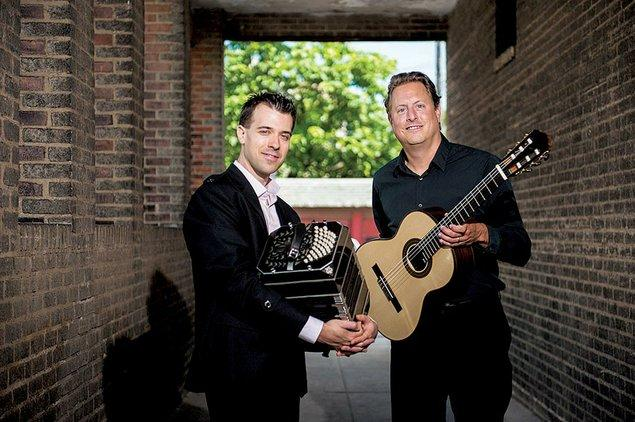
The opening concert (June 8 at 7:30 pm) by guitarist Jason Vieaux and accordionist Julien Labro was pure fun. While their combination of instruments may seem to be a mismatch, for the past ten years the duo has proven that talented players with like-minded musical esthetics can yield amazing results.
The program began with Labro’s arrangement of Arvo Pärt’s Fratres (“Brothers”). A captivating set of variations on a six-bar theme, the music juxtaposes agitated and dreamy lines, and the duo’s performance was hauntingly beautiful.
Divided between the two halves of the program was Radamés Gnattali’s Suite Retratos, which pays tribute to four pioneering Brazilian composers and bandleaders. And like Vieaux and Labro, these musicians also traveled between the worlds of classical and popular music. “Pixinguinha (Choro)” is sheer Brazilian beach music while “Ernesto Nazareth (Valse),” recalls Nazareth’s influences by Chopin and African rhythms. The Duo’s performance was highlighted by spot-on unison passages and inspired improvisations — long lines that ebbed and flowed. “Anacleto de Madeiros (Schottisch)” found the players trading off witty solos, and the concluding “Chiquinha Gonzaga (Corta Jaca)” was a fast dance with Labro traveling up one side and down the other of the button accordion during a wild improv that Vieaux matched note for note.
Introducing Piazzolla’s popular Escualo, Labro quipped that he had played it so many times he couldn’t stand it anymore, and if they were going to perform it they needed to find a new way to approach the piece. Their arrangement is a deconstruction of the original — and why not? Piazzolla created a “new” tango, and now the duo have returned the favor with a new Piazzolla, complete with some reggae and a little Beyoncé.
A recent addition to their repertoire is Bulgarian guitarist and composer Rossen Balanski’s Prelude and Scherzo. The extended Prelude opens with a simple line in the guitar that gradually becomes chromatic. The Scherzo is defined by percussive motifs and rhythmic accents, as well as an impassioned accordion solo in the slower middle section. The duo performed it brilliantly.
The evening also included Vieaux’s arrangement of Pat Metheny’s Antonia with Labro on accordina. The playing was mesmerizing. An encore came as no surprise — Tears for Fears’ Everybody Wants to Rule the World. —Telin
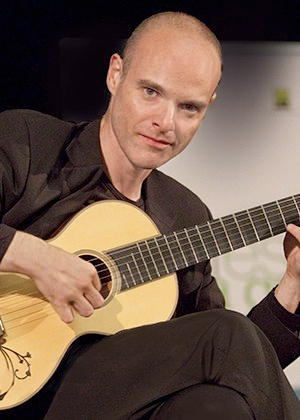
An Argentine native but a New Yorker since his early 20s, Jorge Morel wrote his Sonatina for David Russell as a bridge between the classic repertoire and the popular music of Latin America. The first two movements are meditative, the third a toccata with some bluesy chords, and Gallén played them with sophistication and fine nuances.
Three light classical pieces by Venezuelan composer Antonio Lauro — Carora, La Negra, and Natalia — were delightful miniatures. Their spirit carried over into the sprightly figuration of two waltzes by the Paraguayan-born Agustín Barrios, who lived in half a dozen South American countries, plus Germany. Gallén ended his first set with Barrios’ well-known La Catedral, its three movements in turn pensive (“Préludio”), chorale-like (“Andante Religioso”), and lively with passagework (“Allegro solemne”).
A single work completed the program: both volumes of Cuban composer Leo Brouwer’s Danzas Rituales y Festivas, intended to represent the transcendence of dance as Ravel did in La Valse, but without losing touch with its folk origins. Playing from an iPad, Gallén captured the essence of six Cuban dance forms which ranged in mood from the solemn to the vivacious, becoming more dissonant and abstract as the suite went on, and ending with an energetic Tango featuring an arresting three-chord figure. —Hathaway
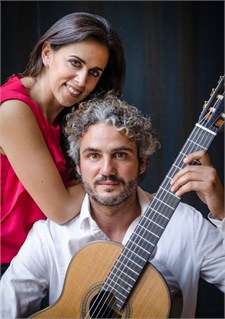
French composer Antoine de Lhoyer’s early 19th-century Duo No. 3 boasts masterful themes and a harmonic structure that could rival many works of the Viennese Classical period — and the rondo theme of the third and final movement bears an uncanny resemblance to Mozart’s 40th Symphony. Sitting knee-to-knee, the Duo played with impeccable ensemble.
Their arrangement of Nikolai Kapustin’s piano Toccatina was not entirely convincing: transferred to plucked instruments, the original material became more noise than notes. Better choices for appropriation by guitars were three of Domenico Scarlatti’s ever-delightful Sonatas (K. 204, 9, and 18), which contrasted fast and slow 6/8 movements and featured virtuosic runs in thirds.
The Duo’s version of Enrique Granados’ charming and sentimental Valses Poéticos worked very well, and their mutual rubatos clicked together brilliantly. They ended their set with Astor Piazzolla’s Tango Suite, the composer’s only work for two guitars. Tapping on the bodies of their instruments enhanced the flavor of the music, as did their adherence to the title of the middle movement, “Andante rubato melancolico.” Argentine music just has to have a dark, brooding quality (when it’s not visiting the opposite emotional polarity), and the Duo nailed that. Repeated “bravos” brought them back onstage twice, the second time for an encore. —Hathaway
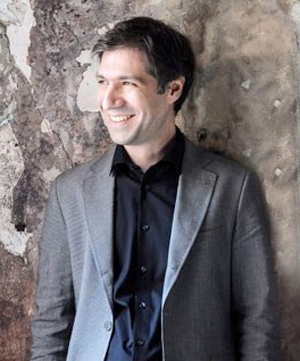
The guitarist began with his own arrangement of the lute Suite in c by Leopold Weiss. Although it is not technically easy to transfer lute writing to the guitar, Hatzinikolaou was more than up to the challenge. He beautifully shaped the “Prelude,” performing with a warm, lush sound. The guitarist easily negotiated the tricky, fast passages of the lively “Courente,” which he followed with a well-phrased “Bourree.” The lovely “Sarabande” was highlighted by long, ornamented lines, and the quirky “Minuet” gave way to a spirited “Gigue.”
The Weiss served as the perfect appetizer for Benjamin Britten’s Nocturnal, a theme and variations based on John Dowland’s Come, Heavy Sleep. As the title suggests, the engaging work is about dreams, each of which Hatzinikolaou captured with aplomb. The final variation and the transition into Dowland’s tune itself was captivating for the guitarist’s delicate, introspective approach. It was a magical moment when the tune finally arrived, and the concluding note drifted away into silence.
Originally written for violin and guitar, Hatzinikolaou’s arrangement of Paganini’s Grand Sonata provided the guitarist with ample opportunity to show off his own bag of tricks. The “Allegro” is full of technical wizardry, while the “Romance” paints a love forlorn before turning into an opera aria. The theme of the concluding “Andantino Variato” is jolly, and the performance was full of color changes that perfectly captured the mood of each variation.
The eight short movements from Federico Moreno Torroba’s Castillos de España were delightful. The “Turègano” is cheerful, the “Torija” lyrical, and the very brief “Manzanares el Real” spritely. This set of miniatures also included the fast and catchy “Alcañiz,” a jazz-flavored “Alba de Tormes,” and the virtuosic “Alcázar de Segovia.”
Emilio Pujol’s celebratory Tres piezas españolas brought the concert to a radiant conclusion. Here the guitarist easily tossed off the many fast flourishes of the “Tonadilla,” which he followed with a sensual “Tango,” before launching into the fast, rhythmic dance, “Guajira.”
Hatzinikolaou clearly had a number of fans in the audience, which he acknowledged with an encore, a refined performance of Agustín Barrios’ Prelude in c. —Telin
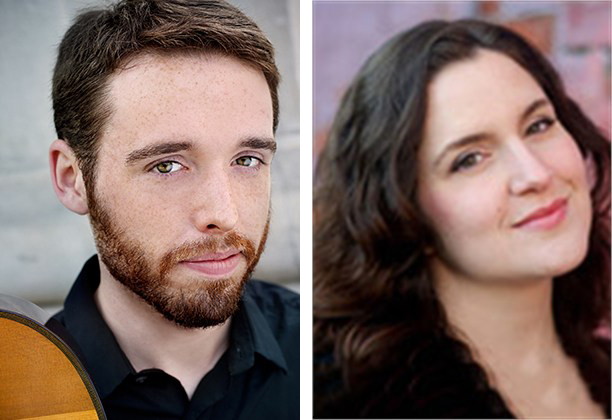
The program moved to the Romantic period by way of two selections from Clara Schumann’s Sechs Lieder and two from Robert Schumann’s Liederkreis. It was interesting to hear these songs performed with guitar — it took them out of a stately parlor and put them into a café. The soprano brought beautiful phrasing to “Ich stand in dunklen Träumen” (I stood in darkened daydreams) from Sechs Lieder, and sounded effortless during “Mondnacht” (Moon-night) from Liederkreis.
Libby Larsen set her Three Rilke Songs for guitar and high voice to the poetry of Bohemian-Austrian poet and novelist Rainer Maria Rilke. Larsen’s music is full of emotion and interesting harmonies, and features a busy guitar part under angular vocal lines. Gomez’s English diction was impressive. Her delivery of the line ‘I will buy fruit’ from “Requiem” was pointed and rhythmically exact. The concluding two lines of “I Am, You Anxious One,” sung on a single high note, were stunning. The highlight of the piece was the 3/4 timed “If I Had Grown Up.” The soprano’s proclamation of the spoken line ‘I grieve for you / In my broad hands your tininess is lost,’ was bone-chilling.
No concert for guitar and female voice would be complete without Manuel de Falla’s Siete canciones populares españolas. It’s hard to become weary of this piece no matter how many times you hear it, and Davin and Gomez made it sound as fresh as could be.
The evening’s first world premiere, Richard Beaudoin’s alluring Three Moraga Songs, is set to text by Xicana poet and essayist Cherríe Moraga. Beaudoin’s writing grabs your attention from the beginning. During “A view of Three Bridges,” Gomez’s clear enunciation of ‘I watch for clues’ was ornamented with vocal inflections. The simple vocal line of “Sensation” included a dramatic repetition of the word ‘extricate’ over a powerful guitar line. As she sang ‘I watch myself for clues,’ Gomez slid down to her lower register. The final word, ‘again,’ grew to stunning volume before the work’s return to the first poem. Throughout the piece, Gomez filled the hall with sound and produced some captivating whispers.
Although inspired by the Far East, Britten’s Songs from the Chinese make almost no references to Chinese music; still, his whimsical music is fun to hear. The soprano sang the fast words during “Big Chariot” with exquisite diction. In “Depression,” Davin took matters into his own hand by playing unforgiving glissando lines steel-guitar style to stunning effect.
The second world premiere, Becca Stevens’ Three Songs set to poetry by Jane Tyson Clement, is a fascinating co-mingling of Art Song, folksong, and David Crosby. Here Gomez’s experience with the experimental vocal ensemble Roomful of Teeth was in evidence as she easily moved between these styles. Stevens’ simple setting of “For You the Night Is Still” is arresting. Except for a few plucked chords on the charango by Davin, the final stanza was sung a capella — the effect was intense. Switching to guitar, Davin provided a steady beat for the soprano’s semi-sung lament in “I Am No Artist,” Gomez delivering those words as if she were chastising herself. The third setting, “Response to Criticism,” is jazz-tinged with a slight swing, and ends on an unresolved chord.
In the final work on the program — the hauntingly beautiful Bachianas Brasileiras no. 5 of Heitor Villa-Lobos — Gomez’s muffled humming said good-bye to the Cleveland International Classical Guitar Festival for another year. —Telin
Published on ClevelandClassical.com June 18, 2018.
Click here for a printable copy of this article



